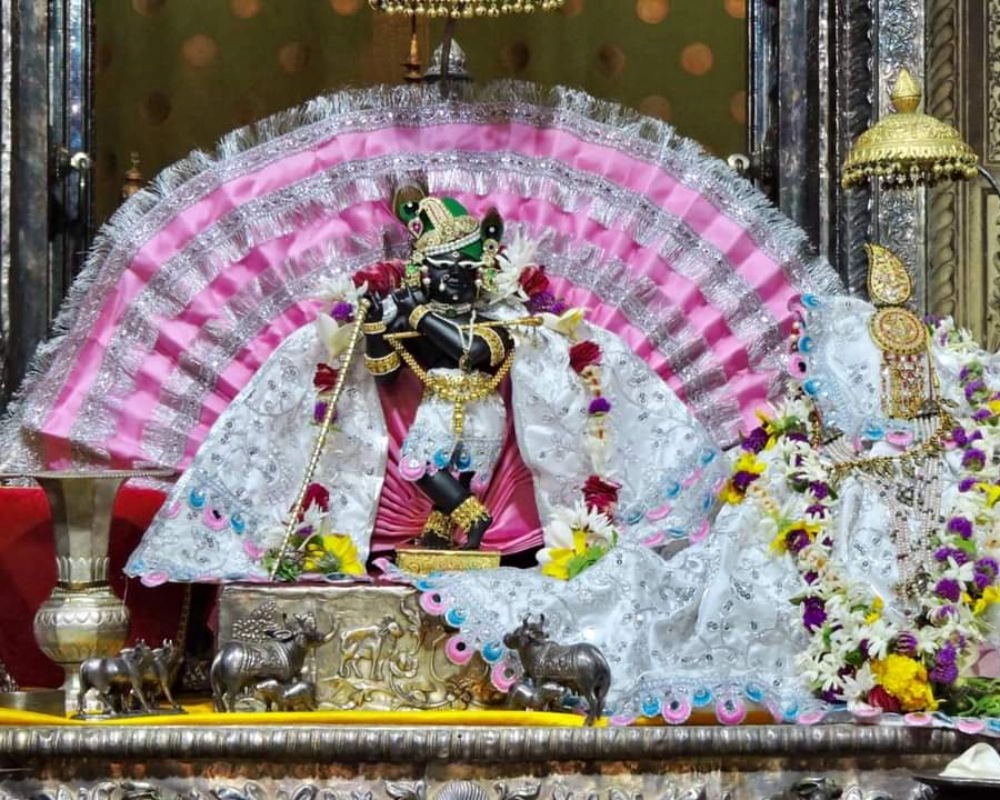Prem Mandir
Nestled in the sacred town of Vrindavan, Uttar Pradesh, Prem Mandir (Temple of Love) stands as a maj...

In the divine town of Vrindavan, where every stone echoes the love story of Radha and Krishna, stands a sacred and spiritually powerful temple – the Radha Raman Temple. This temple, known for its intense spiritual atmosphere and exquisite deity of Lord Krishna, attracts thousands of devotees and pilgrims each year.
The Radha Raman Temple was established in 1542 AD by Gopala Bhatta Goswami, one of the six renowned Goswamis of Vrindavan who were direct followers of Sri Chaitanya Mahaprabhu. According to historical accounts, Gopala Bhatta Goswami was an ardent devotee of Lord Krishna and desired to worship Him in the Shaligram form.
One day, while bathing in the Gandaki River in Nepal, he collected 12 Shaligram Shilas. He worshipped them with great devotion. On Narasimha Chaturdashi, in response to his sincere prayers, one of these Shilas miraculously transformed into a beautiful deity of Radha Raman, meaning “the lover of Radha.” This unique deity is considered self-manifested (Swayambhu), which is a rare and powerful occurrence in Hindu tradition.
What makes this temple special is the absence of a separate idol of Radha Rani. Instead, a crown is placed next to the deity of Krishna to signify Her presence. The main deity of Radha Raman is carved from a single black Shaligram stone and is extremely detailed – showcasing Krishna’s flute, peacock feather, and elegant standing posture.
The deity is not just spiritually revered but also artistically praised for its fine craftsmanship and divine aura. It is said that even the Mughal emperor Aurangzeb, who destroyed many temples, was awestruck by the beauty of this idol and chose not to harm it.
The Radha Raman Temple architecture reflects Rajasthani and Mughal styles, built with red sandstone and decorated with beautiful carvings. Unlike many temples in Vrindavan, the original deity is still worshipped in the same spot since the 16th century, with no relocation or damage.
The temple has a peaceful courtyard, marble floors, and intricately designed domes. The inner sanctum where the deity resides is serene, and the fragrance of sandalwood, incense, and tulsi fills the air.
The temple follows a strict daily seva (service) schedule. The deity is adorned with different outfits and jewelry during the day and offered multiple bhogs (food offerings). The Mangala Aarti (early morning worship) is considered especially auspicious.
Some of the major festivals celebrated at Radha Raman Temple include:
Janmashtami – the birth of Lord Krishna
Radhashtami – the appearance day of Radha Rani
Narasimha Chaturdashi – marking the deity’s manifestation
Holi and Kartik Month – with special decorations and extended kirtans
During these times, the temple is filled with devotional singing (kirtans), bhajans, and spiritual discourses.
Unlike many temples that were damaged during historical invasions, the Radha Raman Temple stands untouched and unchanged. This fact, along with the miraculous appearance of the deity, adds to its spiritual potency. Devotees believe that darshan (divine viewing) of Radha Raman can purify the soul and remove material obstacles from one’s life.
This temple is also a center for Vaishnava teachings, and many scholars and saints from around the world visit to study scriptures and engage in devotion.
Radha Raman Temple is located in the heart of Vrindavan, near Loi Bazaar. It is easily accessible by road and is around 10 km from Mathura Railway Station. The best time to visit is during early morning aarti or during evening darshan, when the atmosphere is most devotional.
Nestled in the sacred town of Vrindavan, Uttar Pradesh, Prem Mandir (Temple of Love) stands as a maj...
Nestled in the narrow, vibrant lanes of Vrindavan, Uttar Pradesh, the Banke Bihari Temple is one of ...
Rising in the heartland of Lord Krishna’s birthplace, Vrindavan Chandrodaya Temple is not just a tem...
The ISKCON Temple, often recognized by its beautiful domes, serene atmosphere, and the enchanting ch...
